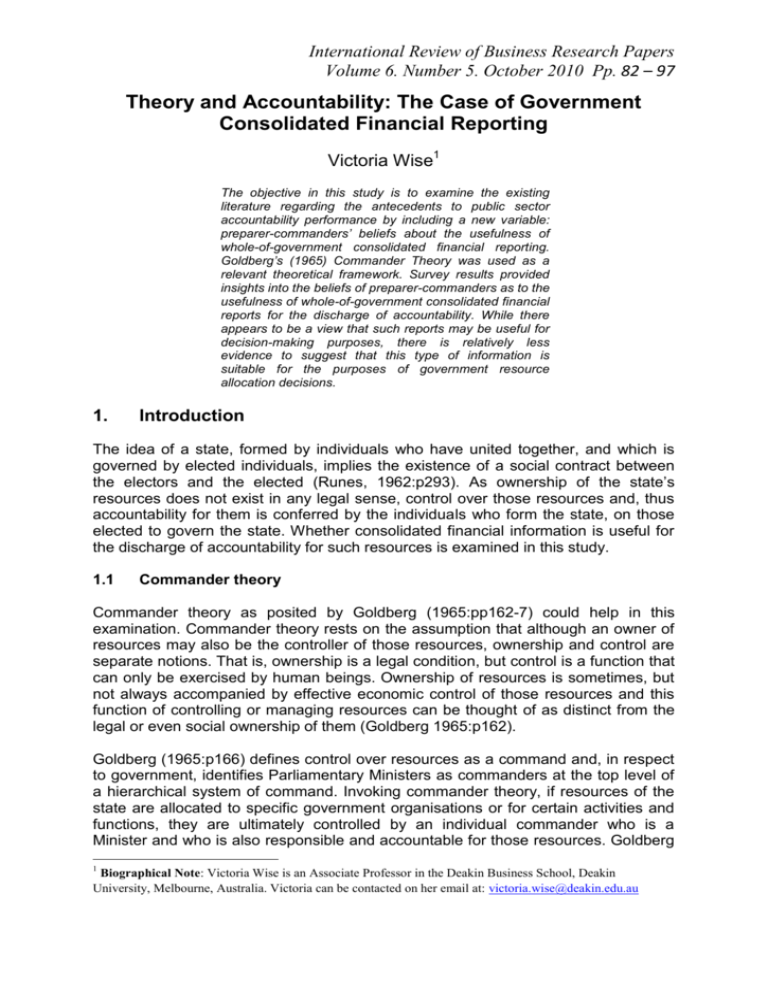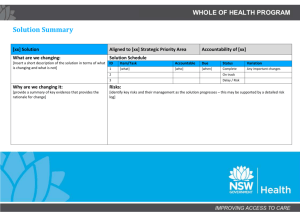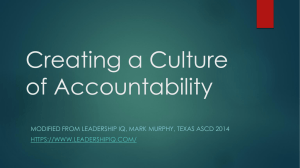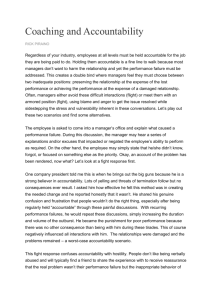Theory and Accountability: The Case of Government Consolidated
advertisement

International Review of Business Research Papers Volume 6. Number 5. October 2010 Pp. 82 – 97 Theory and Accountability: The Case of Government Consolidated Financial Reporting Victoria Wise1 The objective in this study is to examine the existing literature regarding the antecedents to public sector accountability performance by including a new variable: preparer-commanders’ beliefs about the usefulness of whole-of-government consolidated financial reporting. Goldberg’s (1965) Commander Theory was used as a relevant theoretical framework. Survey results provided insights into the beliefs of preparer-commanders as to the usefulness of whole-of-government consolidated financial reports for the discharge of accountability. While there appears to be a view that such reports may be useful for decision-making purposes, there is relatively less evidence to suggest that this type of information is suitable for the purposes of government resource allocation decisions. 1. Introduction The idea of a state, formed by individuals who have united together, and which is governed by elected individuals, implies the existence of a social contract between the electors and the elected (Runes, 1962:p293). As ownership of the state‟s resources does not exist in any legal sense, control over those resources and, thus accountability for them is conferred by the individuals who form the state, on those elected to govern the state. Whether consolidated financial information is useful for the discharge of accountability for such resources is examined in this study. 1.1 Commander theory Commander theory as posited by Goldberg (1965:pp162-7) could help in this examination. Commander theory rests on the assumption that although an owner of resources may also be the controller of those resources, ownership and control are separate notions. That is, ownership is a legal condition, but control is a function that can only be exercised by human beings. Ownership of resources is sometimes, but not always accompanied by effective economic control of those resources and this function of controlling or managing resources can be thought of as distinct from the legal or even social ownership of them (Goldberg 1965:p162). Goldberg (1965:p166) defines control over resources as a command and, in respect to government, identifies Parliamentary Ministers as commanders at the top level of a hierarchical system of command. Invoking commander theory, if resources of the state are allocated to specific government organisations or for certain activities and functions, they are ultimately controlled by an individual commander who is a Minister and who is also responsible and accountable for those resources. Goldberg 1 Biographical Note: Victoria Wise is an Associate Professor in the Deakin Business School, Deakin University, Melbourne, Australia. Victoria can be contacted on her email at: victoria.wise@deakin.edu.au Wise also envisaged lower levels of command. These comprised permanent Heads of Department who guide the policy of Ministers. Effectively, they are commanders in this respect as well as in their capacity of carrying out policy decisions. Goldberg (1965:p167) submitted that accounting reports are prepared by lower-level commanders to commanders at a higher level to serve many purposes. For instance: to provide documentary evidence for decisions made by commanders; for control of activities relating to resources; to enable decisions to be made by resource controllers; and, to allow decisions to be made on a basis of reasoned interpretation rather than guesswork. Commander theory forms a theoretical foundation in which to analyse the impact of a cross-sector transfer of accounting principles and rules to the public sector. It provides a strategic posture toward financial report disclosure activities and assists in developing an understanding of the relative power of report preparers‟ on levels of financial report disclosure. This theoretical framework can be used to help explain whether certain environmental artefacts constitute significant impediments to the cross-sector transfer of the consolidated financial reporting practice to the public sector. Specifically, it provides an examination of the beliefs of the top-level and lower-level commanders as to the usefulness of consolidated financial reports for accountability purposes. Goldberg‟s top-level commanders use consolidated financial reports to discharge their accountability for government resources under their control. They constitute the primary financial report user group in this study and will be described as „usercommanders‟. Heads of Departments are authoritative public sector policy-makers in respect to guidance for financial report content and preparation. They are described as „dominant preparer-commanders‟ in this study. Public sector officials responsible for the compilation and exercise of judgment in the preparation of such reports, and the Auditors-General responsible for monitoring the reporting process and the output of that process are described as „subordinate preparer-commanders‟. 1.2 Consolidated financial reporting Consolidated financial reporting is an accounting technique in which two or more individual entities are reported as if they are one common entity. In order to prepare consolidated financial reports, separate sets of accounting reports are aggregated and certain other adjustments made to arrive at consolidated totals. For instance inter-entity security holdings are eliminated, as are inter-entity transactions and the profits (or losses) (Chambers 1969:pp631-2). Consolidated financial reporting in the Australian private sector has been regulated by an accounting standard since June 1992 however it was not until June 1999 that this particular form of financial reporting was required to be applied by Australian government entities at the whole-ofgovernment level. 1.3 Accountability and usefulness A substantial body of literature exists on accountability and performance, much of it having been produced across the last four decades. What stands out in the relevant literature is the multiplicity of views with respect to the notion of accountability, and the nature of relationships between these factors and the practice of consolidated 83 Wise financial reporting (Simms, 1999). Some researchers in this field have implied that this is partly due to the poor conceptualisation of the nature of accountability and the weak theoretical foundation of the consolidated financial reporting literature (Walker, 1976:p114). The accounting regulators clearly link the concepts of control and accountability and view control as the appropriate criterion for determining the components of the whole-of-government entity for the purposes of providing useful financial information. However, what appears to be lacking are models of accountability and of consolidated financial reporting that can be viewed as superior or that are generally favoured in the literature. In the Australian public sector, Ministerial Heads of Departments are accountable to an elected assembly of Parliamentary Ministers (Birch, 1996:p20), and at a party level to the governing party (Lucy, 1993:p3). The Auditors-General provide assurance as to the accountability of public sector operations and performance, and the wider political processes of elections and interest group advocacy connect Parliament through its Ministers, to the people and so makes government more open than it would otherwise be (Aldons, 2001). Broadbent and Laughlin (2003) argue that despite this implied notion of accountability governments only make themselves accountable in a political rather than a managerial sense. The Australian conceptual framework directing financial reporting (the „conceptual framework‟) identifies two variables as antecedents to usefulness of financial information: these are relevance and reliability. Further, the consolidated financial reporting technique is identified as a method that produces relevant financial information that is useful to users of financial reports for their own decision-making purposes. A focus in this study is whether consolidated financial reports are a useful tool for the discharge of the accountability for government resources. 1.4 Research questions and study objectives In specifying the major research question, the achievement of one principal research objective is sought. This objective is to extend, significantly, the existing literature regarding the antecedents to public sector accountability performance by including a new variable: preparer-commanders‟ beliefs about the usefulness of whole-ofgovernment consolidated financial reporting. On this basis, the major research question is presented: Are whole-of-government consolidated financial reports useful for the discharge of financial information accountability by commanders? 1.5 Importance of the topic The significance of this study relates to the sector under study. Much of the prior research on the concepts of accountability, usefulness and of the consolidated financial reporting methodology, has been conducted in the context of the private sector. Carnegie and Napier (1996) argued that the historical imbalance of financial reporting investigation towards the private sector might be reflecting a bias towards activities of professional accountancy practice and the use of economic models of decision-making based on notions of profit maximisation. Thus the public sector is a jurisdiction of interest: and, because it has embarked upon a fundamental change in 84 Wise the organisational structure of its business operations, its approach to profitability performance, its accountability for resource management, and the usefulness of its reported financial information. With governments generally focussing more attention on the efficiency and effectiveness of public sector management and accountability, and extending the application of full accrual accounting systems for financial reporting purposes, an examination of an important and radically different financial reporting methodology in this sector is likely to yield useful information. 1.6 Organisation of this paper In the next section the main streams of literature which are central to the study topic are summarised. The outcome of a questionnaire canvassing the views of public sector policy-makers and report preparers of the usefulness of whole-of-government consolidated financial reports is then presented. This includes a discussion of the research design, questionnaire development, data collection procedures, measures used, data preparation procedures and the statistical analysis. Finally the contributions made by this study to the relevant literature on the accountability performance, usefulness of financial report information and government consolidated financial reporting are presented. 2. Literature review 2.1 Accountability It has been proposed in this study to investigate the financial information accountability paradigm for commanders of whole-of-government consolidated financial reports. The accountability paradigm is now identified. The Macquarie Dictionary (1985) describes accountability as a concept in which there is a liability or responsibility to a person, for an act. It describes an accountant as one whose profession is to communicate economic information for the judgment and decision-making purposes of individuals who seek it. The Australian Pocket Oxford Dictionary (1993) extends the notion of accountability to the public and especially to persons affected by an organisation‟s operations. The literal meaning of accounting according to Day and Klein (1987:Ch1), is for relevant persons to give an explanation of what they do, to those to whom they are responsible and whose authority empowers them or gives them the right to demand such an explanation. Thus accountability is essentially an informing function and raises the questions of who is accountable to whom, for what are they accountable, what are the means or processes for obtaining these accounts, and what are the results or outcomes, including sanctions of all this (Mosher, 1979:p236). The regime of government organisation in Australia indicates that responsible government and accountability are intertwined. Responsible parliamentary government (Lucy, 1993:p318; Galligan, 1993; Uhr, 1998:p81) means that the ministerial heads of government departments are accountable to an elected assembly (Birch, 1996:p20). On the other hand, responsible party government is taken to mean accountability to the governing party rather than to any other group or institution (Lucy, 1993:p3). Responsible government, by connecting Parliament through its Ministers to the electorate, makes government accountable to the 85 Wise electorate. Accountability in this context is associated with the justification or giving of reasons for conduct and for responsibilities or authority granted. Justifications according to Littleton (1953:p15) provide the rationale for regulated financial disclosure. Guthrie, Parker and English (2003:p7) assert that governments are always accountable to Parliament and the electorate for all of their activities. Both State and Commonwealth parliaments provide a powerful accountability forum through the process of parliamentary scrutiny and committee investigations (Clark, 1999). Political opponents also can have a considerable impact on accountability through their ability to question government policy and performance. For example, in the United States (US) the Governmental Accounting Standards Board (GASB) acknowledged (1987) its belief that accountability is the cornerstone of government when it stated that the key objectives of government financial reporting included the disclosure of information on a government entity‟s financial condition. The GASB also articulated its belief that the public had a right to question government when it stated (GASB, 1987:p28) that: “Governmental accountability is based on the belief that the citizenry has a right to know, and a right to receive openly declared facts that may lead to public debate by the citizens and their elected representatives.” Beyond the parliamentary process, accountability is related to the wider political processes of elections and interest group advocacy. The media and political commentators play an important facilitating role through their freedom of inquiry and comment. Hardman (1996:p3) observed a growing disinclination amongst the media, academe and Auditors-General to maintain what he described as „... a discreet and respectful silence ... and certainly not harass or upset the government of the day with audit enquiries ...‟. A political viewpoint The work of writers in the area of accountability (Thynne & Goldring, 1987; Uh, 1993, 1998; Parker & Gould, 1999; Simms & Keating, 1999) reveals that the term „accountability‟ is imprecise. Uhr (1993) linked the notion of accountability to its root meaning of being called to account for an explanation of one‟s actions or conduct. He (Uhr, (1998:p151) stated that „few political terms attract such confusion‟ as accountability. Uhr‟s (1993) view is similar to the notion of responsibility expressed by Thynne and Goldring (1987) which they described as a situation where officials are accountable for the performance of their official tasks and therefore subject to an institution‟s or person‟s oversight, direction or request that they provide information on their action or justify it before a review authority. Simms and Keating (1999:p116) suggested that „there are many different kinds of accountability and that there may be clashes between them‟. Parker and Gould (1999) considered that while accountability may be difficult to define, it is fundamental to our system of government. Within the hierarchical Westminster system of government administration that has historically underpinned the administrative system of the Australian public sector, accountability is narrowly confined to a relationship of inequality between two parties. 86 Wise One, a subordinate, is required to report to another, a superior (Mulgan, 1997b) without any direct reporting to either parliament or the public. O‟Loughlin (1990:p281) suggested that accountability takes place within such a relationship as the „superior is expected to have an interest in assessing and improving the quality of the performance offered by the subordinate‟. Sumner (1987) provided a broader view of accountability under the Westminster tradition that attached obligations to the community to any individual rights that were formalised and sanctioned under parliamentary sovereignty. Thus it can be seen that in the political sphere, accountability is an abstract concept that may change over time, and which can be connected to the concept of responsible government. Over the last three decades am administrative modernisation has occurred within the public sector as government operations have become more efficient and effective (Weller & Lewis, 1989: Guthrie, 1990; Parker & Guthrie, 1990). As a result of this evolving process public servants are now said to be accountable, not only to their immediate superiors, but also to a range of oversight bodies such as the AuditorGeneral (Reid, 1984). The suggestion that public servants are directly accountable to members of the public has been opposed in some quarters. For instance, by the Department of the Prime Minister which published analysis of accountability in the public sector (MAB/MIAC, 1991, 1993) in which clear priority is given to the duty of public servants to their immediate superiors. This form of relationship precludes any exercise of discretion by subordinates in the hierarchical chain of command and probably also absolves their professional consciences. However, it would be a mistake to associate accountability of public servants exclusively with their duty to Ministers and the immediate superiors who direct them, as this is only one aspect of a broader structure of accountability in which the general framework is set by the accountability of all public officials to the public. It has been assumed that many public servants recognise a general duty to the public in addition to their primary duty to their superiors (Campbell & Halligan, 1992). The MAB/MIAC Report (1993) in fact, also hints at such a wider concept of accountability by acknowledging that scrutiny by external review bodies has become an integral and important part of the modern accountability process. Corbett (1992) suggested that public servants may have an inward accountability to their professional consciences. It is a general expectation that public servants will act responsibly and conscientiously and, in extreme situations, follow their own judgment against the instructions of their superiors (Jackson, 1993). Such actions of initiative and professional judgment may have implications for the effective application of new administrative or regulatory practices such as accounting method choice, or the cross-sector transfer of accounting standards. Thus, accountability appears to have evolved into a vehicle for reconciliation of the demand for more consultation and public participation and the changes to the focus of public management that occurred across the 1980s (Chapman, 2000). It has been suggested that the emerging scenario is one of tighter control of public servants through notions of responsible government (Emy & Hughes, 1993) and accountability (Thynne & Goldring, 1987). 87 Wise An agency perspective Mulgan (2000) provided a view of accountability referring to the obligations that arise within a relationship of responsibility where one person or body is responsible to another for the performance of particular services. He described the obligations in question as first: to account for the performance of duties; and second, to accept sanctions or redirection. That is, accountability implies a responsibility by one party to another for the performance of duties and adverse consequences for unacceptable levels of performance. Mulgan viewed an accountability relationship as one of „superior and subordinate or of principal and agent, where subordinates or agents are held accountable to, and receive directions from their superiors‟. This interpretation is consistent with the concept of Responsible Government where Ministers as agents of Parliaments (the Principals) are accountable for their own performance and the resources entrusted to them. Mulgan (2000) contended that in practice an agent is typically the more dominant participant and that this phenomenon creates the need to establish the principal‟s superiority, or control over the agent. He asserted that accountability requirements serve to provide opportunities for otherwise weak principals to impose some controls on individuals and organisations that are supposed to be serving in the principal‟s interests. The very act of reporting to a superior may be sufficient to induce action along the lines preferred by the superior. Similarly, assessments by auditors or other oversight bodies may lead to significant direction of, or alterations in, the behaviour of those audited. For instance, oversight bodies such as the Auditor-General, through their scrutiny and auditing services may provoke responsible behaviour by the agent through the prospect of intervention by the principal. Agency theory posits that a principal controls the actions of the agent by reward if the agent faithfully follows the principal‟s instructions, and by termination of the agent‟s contract if the principal‟s instructions are not followed (Jensen & Meckling, 1976; Watts, 1977). Baiman (1982) provides a specification and survey of agency theory. Self (1985:p165-7) argued that agency theory applied to government implies that senior bureaucrats are not solely agents of a government Minister, they have an independent responsibility for good and equitable administration. From an agency perspective, a Minister is elected to act on behalf of the public as an agent, performing the process of directing and controlling resources for which the Minister carries responsibility. Agency theory assumes, however, that an individual agent may not always act in the best interests of the principal. Such behaviour represents an agency cost (Jensen & Meckling, 1976) and has been described as opportunistic behaviour (Watts & Zimmerman, 1978, 1986, 1990). For example, a Minister may have a self-interest incentive to abandon policies or proposals that might attract adverse media publicity in response to adverse assessments voiced through parliament and elsewhere (Mulgan, 1997a). Ministers (as agents) have a need to be seen to deal effectively and fairly with issues which arise within their own sphere of responsibility and thus to enhance their political reputation and the electoral fortunes of the government. Ministers, like any other chief executives, are required to see that reasonable administrative structures are in place and to intervene when problems come to light. They are expected to 88 Wise deal with major departmental problems as they arise. They cannot afford to appear inactive or complacent once problems are revealed, and are often held politically responsible for any failure to provide prompt and efficient remedies. This indicates that there are strong incentives for Ministers to react positively to public criticism. Corroborating evidence of the power of publicity and public criticism is provided by the continuing resistance of governments to the provision of information that might generate criticism of government actions (Mulgan, 2000). 2.2 Commandership and accountability This form of hierarchical power structure and the element of control provide the ideal conditions for Ministers through the ultimate Heads of Government Departments, Agencies and Statutory Authorities to command the production of specific information. This would include financial information that, as Littleton (1953) pointed out „can be clues to good or bad policies‟. Littleton also argued that: “In accounting, certain aspects of economic truth and some phases of statistical truthfulness are skilfully mingled. The fusion is such as to make accounting information highly useful to anyone who is interested in the activities of a business enterprise.” (Littleton 1953, p:12) If parliamentary Ministers believe financial information is useful for the discharge of their accountability for their conduct and granted responsibilities and authority, then commanding their subordinates to accumulate financial data and to prepare financial reports sufficient to enable them to discharge that accountability would be rational action. Thus, conceptually, the Head of a Government Department, Agency or Authority is a report preparer (preparer-commander) who provides financial information to a parliamentary Minister who is a user-commander, upon which an assessment may be made for ministerial accountability purposes. Goldberg (1965:p166) suggested that in government affairs there is a hierarchy of commanders in which: “Ministerial heads are at the top-level of command, taking decisions in accordance with general Cabinet policy. At lower levels of command are the officials of the several Departments who are charged with the task of deploying resources within the scope and limits laid down for them by budgeting considerations and financial appropriations.” He argued that in all cases someone has supreme responsibility, and that person stands or falls in a personal way by the success or failure of the enterprise. In a similar way, he argued, this applies down the hierarchical chain of command to „agencies, branches, territories and the like‟ (Goldberg, 1965:p166). Within this theoretical framework of control (or command), reporting may be either direct or diffused, and the reporting may be a matter of providing the data for the formation of an informed opinion. Thus, in the context of public sector financial reporting, Goldberg (1965:p167) envisaged financial reports as „reports by commanders to commanders, that is, by commanders at one level of command to commanders at a higher level ...‟. 89 Wise Goldberg saw a Ministerial Head of a Department as a top-level commander. Such a role would entail two separate financial reporting functions: (1) the discharge of parliamentary accountability for controlled resources and granted responsibilities/authority; and (2) policy-making and ultimate responsibility for report preparation. Goldberg (1965) reasoned that accountability was an informing problem to be resolved through the administration and organisation of the resources under a person‟s command. He described the rationale behind this procedure as commandership accounting and that the results of recording external events and internal events constitute an expression of the commander‟s activities that may have been delegated to others in the hierarchical chain of command. Mulgan (1997b:p108) agreed that at each point in this „chains of accountability, officials are accountable to their immediate superiors for their own performance and for the performance of others below them‟. In summary, accountability in the public sector appears to occur within a framework of superior and subordinate in which the superior is expected to have an interest in assessing and improving the quality of the performance offered by the subordinate (O‟Loughlin 1990:281). The accountable are subject to oversight that may be in the form of an assessment of performance or verification as in the auditing of accounts (Uhr ,1993:p1). The superior commonly uses the results of such audits and assessments of performance as a basis for controlling (Thynne & Goldring, 1987), directing or issuing instructions to those who are accountable (Mulgan, 1997b). In addition, it appears that accountability to communicate information about performance and controlled resources can be discharged through the provision of financial information. 2.3 Sector of interest The nine jurisdictions directly represented in the Australian Senate and House of Representatives were selected as the appropriate sectors for study as they are directly represented in parliament and so directly accountable to the electorate. The separate jurisdictions that form this primary group of interest establishing the principle of responsible government are presented in Table 1. Table 1 Primary Group of Interest Governments Commonwealth (C‟wlth) New South Wales (NSW) Queensland (Qld) South Australia (SA) Tasmania (Tas) Victoria (Vic) Western Australia (WA) Northern Territory (NT) Australian Capital Territory (ACT) 90 Wise 2.4 Summary In this section the relevant literature on the major issue of interest in this study was considered. This issue is: the accountability model of financial reporting theory. This body of literature provides a basis for the present study into the usefulness of wholeof-government consolidated financial reports for the discharge of financial accountability. 3.0 Research Methodology and Analysis of Results 3.1 Survey of preparer-commanders A survey approach was adopted in this study, using a mailed questionnaire. Questionnaire methods of data collection are common in the investigation of financial report disclosure. They can provide a first step in identifying and defining features that are likely to influence financial reporting policy choices or lobbying behaviour. A purposive sampling technique was chosen as a means of producing a sample that is typical of the cases of interest. That is, dominant and subordinate preparercommanders were chosen as the subjects because the pattern of their responses will provide a good idea of the outcome of whole-of-government consolidated financial reporting, De Vaus (1995) suggests that such a selection method can provide efficient predictions. The size of the sample selected to receive the questionnaire was relatively small. It comprised the Head of the Department of Finance and the Bureau of Treasury, and the Auditor-General from each of the Commonwealth, States and Territories. The sample size was extended in an effort to capture the views of officers in the role of deputies or senior officers. Accordingly, lists of all such officers were accessed from relevant organisation charts and contact lists displayed on the Internet. This approach generated a list of 52 dominant and subordinate preparer-commanders and their deputies and senior advisers. A package comprising the questionnaire and relevant accompanying letters was mailed to each Department/Bureau Head and Auditor-General. A request to distribute the questionnaire to the identified officers and any other relevant officers accompanied each package. Response rate Of the 52 questionnaires sent, 17 usable responses were received. Five questionnaires were sent to the Northern Territory and six questionnaires to Tasmania. Both of these jurisdictions had a response rate of zero. Ryan, Dunstan and Stanley (1999) in a study of responses observed a non-response from Tasmania. For a variety of reasons the subjects selected in these two jurisdictions may not have responded. The concern in this study is whether non-response would create problems of size or bias. In respect to size, probability sampling techniques are unsuitable in this section of the study as the concern is not one of generalising from a sample to a large population. Instead of being concerned with determining what proportion of the population gives a particular response, the study is aimed at obtaining an idea of the ranges of responses or ideas that an authoritative sub-set of the population hold. 91 Wise As regards bias, Smith (1989) suggested that suitable allowances could be made after obtaining information about the source of the non-response. To this effect, two allowances were made in this study in respect to the Northern Territory and to Tasmania. Questionnaire data were sought from the Northern Territory report preparers however the non-response from this source was not unexpected as the majority of questions addressed beliefs and views of preparer-commanders who had actually been involved with the preparation of whole-of-government consolidated financial reports. At the date of this study, preparer-commanders in the Northern Territory had not. Micallef (1997) noted that Tasmania was one of only two jurisdictions that had not committed to preparing consolidated financial reports for the whole-of-government reporting entity. Relative to a number of measures including population and consolidated net assets, Tasmania is less significant than the other States. This has implications for the ability of the State to fund the timely preparation of the whole-of-government consolidated financial reports. As responses were received from the Departments of Finance and Bureaus of Treasury in five of the seven remaining jurisdictions, and from the offices of the Auditors-General in all other jurisdictions, the non-response from the Northern Territory and Tasmania was unlikely to be a significant source of bias in the overall responses. Of the 17 preparer-commander responses received, seven (41%) emanated from the Departments of Finance and Bureaus of Treasury and ten (59%) from the offices of the Auditors-General. Accordingly, the responses received were considered to provide a strong response from these authoritative sources and the response rate was recalculated after eliminating the Northern Territory and Tasmania. 3.2 Questionnaire development Recipients were asked to indicate their views and perceptions on a number of issues related to the consolidated financial reporting methodology and to the usefulness of whole-of-government consolidated financial information. Responses on each variable were sought by using a range of questions and measurement approaches. The strategy of using multiple-item indicators was chosen as a means to ensure more reliable results for each variable than would be the case if only a single question were used for each variable. Different measurement methods were also adopted and three distinct types of question content: beliefs, attitudes and attributes, were included in the instrument. A Likert-style, five-point rating scale approach was adopted for the questions relating to the respondents‟ beliefs about four primary thematic data categories of Usefulness, Scope, Control and Preparation. 3.3 Summary and discussion of data An analysis and interpretation of respondents‟ beliefs was performed in respect to the four primary data themes. The analysis and interpretation was accomplished as follows. First the questions were matched to the appropriate data themes. Second, descriptive statistics from the responses to each of these questions were computed. As questions are designed to address different aspects of the primary themes it was 92 Wise not appropriate to collapse all statistics into a single aggregate. Where several questions covered the same issue they were collapsed into single aggregates. Usefulness of consolidated financial reporting The results indicate an overall belief that whole-of-government consolidated financial reports are useful and that consolidated financial information is comparable. The separate measurements showed that while respondents hold a relatively strong view that whole-of-government consolidated financial information is comparable on an intra-sector basis, they do not believe it is readily comparable to the consolidated financial data of other reporting entities. Respondents believe the reports are understandable. The quality of understandability is regarded by some as an important attribute of effective reporting (Jones, 1988; Schroeder & Gibson, 1990). If financial information is not understandable then decisions such as the resource allocation decisions of government based on information that has not been properly comprehended are questionable (Jackson, 1993). There are two implications of this response (1) that in the respondents‟ view consolidated financial information meets the criterion of understandability; and (2) respondents‟ believe they understand consolidated financial information. The results imply that respondents are not convinced that the benefits of preparing consolidated financial reports outweigh the costs. However, the results indicate a very strong belief that, in terms of costeffectiveness for decision-making, unconsolidated information is much less beneficial than consolidated information. Scope and application of consolidated financial reporting The responses indicated a belief that some benefits of consolidated financial reporting were experienced by both external and internal stakeholders. Control The results provide a firm indication of the respondents‟ belief that the concept of control is appropriate for whole-of-government consolidated financial reporting. The respondents did not appear similarly convinced that ownership was the most appropriate criterion for the application of consolidation accounting in the public sector. This was not an unexpected outcome given that the organisation of entities and services within the public sector has not traditionally been ownership-based, but rather, associated with the sources of funding. The implication drawn from these results is that preparers believe the concept of control is eminently suited to the public sector. The evidence provided support for the concept of the economic entity. However, respondents did not support the consolidation of entities being triggered by a common economic interest such as might occur if the two entities operate in a partnership or joint venture arrangement. Preparation of consolidated financial reports In financial reporting the technical and human resources infrastructures are important as it is the people and the resources available to them that produce the reports. The results indicate a belief that the technical infrastructure of the public sector is adequate to cope with the compilation and preparation of consolidated 93 Wise financial reports. The respondents firmly rejected the suggestion that it was appropriate to aggregate cash and accrual data. Further, support was provided for the notion that consolidated entities should have co-terminous balance dates. 3.4 Summary The summarised results provided insight into the beliefs of preparer-commanders as to the usefulness of consolidated financial reports and their commitment to the crosssector transfer of the method. While there appears to be a belief that whole-ofgovernment consolidated financial information may be useful for decision-making purposes, there was relatively less evidence to suggest that information was suitable for the purposes of government resource allocation decisions. After considering the adequacy of the resources dedicated to providing relevant training, the preparer-commanders‟ view that they „understand the method‟ does not appear to be a matter impeding full implementation of the method. Rather it appears that implementation gaps are more likely to be associated with other matters, for instance, the loose definition of the control concept and the reluctance of report preparers to merge such fundamentally different concepts as the cash and accrualbased methods of accounting. 4.0 Conclusions and Recommendations The purpose of this study was to examine the issues surrounding the cross-sector transfer of a particular reporting practice, consolidated financial reporting, to the Australian public sector. A Commander Theory approach was adopted as an appropriate framework in which to conduct the examination as Commander Theory is ideally suited to the hierarchical system of control over resources that exists within the public sector. The findings provide evidence to support the research question presented in section one of whether whole-of-government consolidated financial reporting is useful for the discharge of financial information accountability by commanders. In considering any changed requirements for the content and format of whole-ofgovernment consolidated financial reports, an appropriate theoretical framework that adequately reflects the nature and operations of government needs to be developed. Underpinning this process is the need to identify in addition to user-commanders, other users of whole-of-government consolidated financial reports and their information requirements as these are likely to be very different to those identified in the private sector. In the absence of this information, the output of the whole-ofgovernment consolidation process will not serve any useful purpose other than by chance. While preparer-commanders including Australian Auditors-General and their senior advisers supported the consolidated financial reporting method as a means of enhancing accountability performance this support cannot be regarded as strong or unambiguous. They appear to have been adversely influenced by the potential problems they would encounter when interpreting or auditing such weakly defined concepts as the economic entity, control and assets. 94 Wise References Aldons, M. 2001, “Responsible, Representative and Accountable Government”, Australian Journal of Public Administration, vol.60, no.1, (Mar), pp.34-43. Australian Pocket Oxford Dictionary 1993, (3e), Oxford University Press, Melbourne. Baiman, S. 1982, “Agency Research in Managerial Accounting: A Survey”, Journal of Accounting Literature, vol.1, pp.154-213. Birch, A. H. 1996, Representative and Responsible Government: An Essay on the British Constitution, Allen & Unwin, London. Broadbent, J. & Laughlin, R. 2003, “Control and Legitimation in Government Accountability Processes: The Private Finance Initiative in the UK”, Critical perspectives on Accounting, vol.14, no.1-2, (Jan), pp.23-48. Campbell, S. J. & Halligan, J. 1992, Political Leadership in an Age of Constraint: Bureaucratic Politics Under Hawke and Keating, Allen & Unwin, Sydney. Carnegie, G. & Napier, C. 1996, “Accounting History into the Twenty-First Century” Research Paper 5/96, Accounting, Finance and Law Research Unit, Department of Accountancy & Law, Victoria University, Melbourne. Chambers, R. J. 1969, Towards a Theory of Accounting: Consolidated Statements are not really Necessary in Accounting Finance and Management, Arthur Andersen & Company, pp.631-5. Chapman, R. 2000, “Accountability: Is Westminster the Problem?” Australian Journal of Public Administration, vol.59, no.4, pp.116-21. Clark, L. 1999, “The Politics of Regulation: A Comparative-Historical Study of Occupational Health and Safety Regulation in Australia and the United States”, Australian Journal of Public Administration, vol.58, no.2, pp.94-104. Corbett, D. 1992, Australian Public Sector Management, Allen & Unwin, Sydney. Cushing, B. & Loebbecke, J. K. 1986, Comparison of Audit Methodologies of Large Accounting Firms, American Accounting Association, Research Project. Day, P. & Klein, R. 1987, Accountabilities: Five Public Services, Tavistock, London. De Vaus, D. (1995), Surveys in Social Research, (4e), Allen & Unwin, Sydney. Emy, H. & Hughes, O. 1993, Australian Politics: Realities in Conflict, MacMillan, Melbourne. Galligan, B. 1993, “Parliamentary Responsible Government and the Protection of Rights”, Public Law Review, vol.4, no.2, pp.100-12. GASB (Governmental Accounting Standards Board) 1987, Concept Statement No. 1: Objectives of Financial Reporting, Stamford, Connecticut. Goldberg, L. 1965, An Inquiry into the Nature of Accounting, American Accounting Association, Monograph No.7, State University of Iowa. Guthrie, J. 1990, “The Adoption of Corporate Forms for Government Undertakings: Critical Issues and Implications”, The Public Sector: Contemporary Readings in Accounting and Auditing, Guthrie, J., Parker, L. & Shand, D. (Eds.) Harcourt, Brace, Jovanovich, Sydney, pp.209-21. Guthrie, J., Parker, L. & English M. 2003, “A Review of New Public Financial Management Change in Australia”, Australian Accounting Review, vol.13, no.2, pp.3-9. Hardman, D. 1996, “Ethical Implications of the Public Sector Auditing Function”, Faculty of Business Working Paper Series, School of Accounting, University of Technology, Sydney. 95 Wise Jackson, B. 1993, “easuring Understandability of Corporate Communication: A New Zealand Perspective”, Discussion Paper Series, Accountancy Department, Massey University, New Zealand. Jensen, M. C. & Meckling, W. H. 1976, “Theory of the Firm: Managerial Behaviour, Agency Costs and Ownership Structure”, Journal of Financial Economics, vol.3, no.4, (Oct), pp.305-60. Jones, J. M. 1988, “A Longitudinal Study of the Readability of the Chairman‟s Narratives in the Corporate Reports of a UK Company”, Accounting and Business Research, vol.18, no.72, pp.297-305. Littleton, A. C. 1953, Structure of Accounting Theory, Illinois, American Accounting Association. Lucy, R. 1993, The Australian Form of Government: Models in Dispute, (2e), MacMillan, Melbourne. MAB/MIAC (Management Advisory Board/Management Improvement Advisory Committee) 1991, Accountability in the Commonwealth Public Sector: An Exposure Draft, Australian Government Printing Service, Canberra. MAB/MIAC (Management Advisory Board/Management Improvement Advisory Committee) 1993, Accountability in the Australian Public Sector, Australian Government Printing Service, Canberra. The Macquarie Dictionary 1985, rev. Macquarie Library, Sydney. Micallef, F. 1997, “Financial Reporting by Governments: The Big Picture”, Charter, vol.68, no.1, (Feb), pp.50-1. Mosher, F. . 1979, The GAO: The Quest for Accountability in American Government, Westview Press, Boulder, Colorado. Mulgan, R, 1997a, „The Processes of Public Accountability‟, Australian Journal of Public Administration, vol.56, no.1, pp.25-36. Mulgan, R, 1997b, “Contracting Out and Accountability”, Australian Journal of Public Administration, vol.56, no.4, pp.106-16. Mulgan, R, 2000, “Comparing Accountability in the Public and Private Sectors”, Australian Journal of Public Administration, vol.59, no.1, pp.87-98. O‟Loughlin, M. G. 1990, “What is Bureaucratic Accountability and How Can We Measure it?”, Administration and Society, vol.22, pp.275-302. Pacecca, T. 1995, “An Analysis of Submissions to the ASRB on Release 411 „Foreign Currency Translation – Questionnaire‟ ”, Accounting and Finance, (Nov), pp.97-118. Parker, L. & Gould, G. 1999, “Changing Public Sector Accountability: Critiquing New Directions”, Accounting Forum, vol.23, no.2, pp.109-36. Parker, L. & Guthrie, J. 1990, “Public Sector Accounting and the Challenge of Managerialism”, in Budgetary Management and Control: The Public Sector in Australia, Forster, J. & Wanna, J. (Eds.) MacMillan, Melbourne, pp.114-27. Reid, G. S. 1984, “The Westminster Model and Ministerial Responsibility”, Current Affairs Bulletin, no.61, pp.4-16. Runes, D. A. 1962, Dictionary of Philosophy, Littlefield Adams & Co., New Jersey. Ryan, C., Dunstan, K. & Stanley, T, 1999, “Constituent Participation in the American Public Sector Accounting Standard-Setting Process: The Case of ED55”, Financial Accountability and Management, vol.15, no.2, (May), pp.173-200. Schroeder, N. & Gibson, C. 1990,”„Readability of Management‟s Discussion and Analysis”, Accounting Horizons, (Dec), pp.78-87. Self, P. 1985, Political Theories of Modern Government, Allen & Unwin, Sydney. 96 Wise Simms, M. 1999, “Accountability in Australian Government: Towards the Year 2000”, Australian Journal of Public Administration, vol.58, no.1, (Mar), p.33. Simms, M. & Keating, M. 1999, “Accountability in Australian Government – Symposium”, Australian Journal of Public Administration, vol.58, no.1, pp.33101. Smith, T.W. 1989, “The Hidden 25 Percent: An Analysis of Non-response in the 1980 General Social Survey”, in Survey Research Methods: A Reader, Singer, E. & Presser, S. (Eds.), University of Chicago Press. Sumner, L. 1987, The Moral Foundation of Rights, Clarendon Press, Oxford. Thynne, I. & Goldring, J. 1987, Accountability and Control: Government Officials and the Exercise of Power, Law Book Co., Sydney. Uhr, J. 1993, “Redesigning Accountability”, Australian Quarterly, vol.65, Winter, pp.116. Uhr, J. 1998, Deliberative Democracy in Australia, The Changing Place of Parliament, Cambridge University Press, Melbourne. Walker, R. G. 1976, “An Evaluation of the Information Conveyed by Consolidated Statements”, Abacus, (Dec), pp.77-115. Watts, R. L. 1977, “Corporate Financial Statements: A Product of the Market and Political Processes”, Australian Journal of Management, (Apr), pp.52-75. Watts, R. L. & Zimmerman, J. L. 1978, “Towards a Positive Theory of the Determination of Accounting Standards”, The Accounting Review, vol.53, no.1, (Jan), pp.112-34. Watts, R. L. & Zimmerman, J. L. 1986, Positive Accounting Theory, Prentice-Hall Inc., Englewood-Cliffs, New Jersey. Watts, R. L. & Zimmerman, J. L. 1990, “Positive Accounting Theory: A Ten Year Perspective”, The Accounting Review, (Jan), pp.53-78. Weller, P. & Lewis, C. 1989, “Corporate Management: Background and Dilemmas”, in Corporate Management in Australian Government: Reconciling Accountability and Efficiency, Davis, G. P., Weller, P. & Lewis, C. (Eds.), Macmillan, Melbourne, pp.1-16. 97







![Action Plan Training for College of Education [Erickson Hall]](http://s3.studylib.net/store/data/006838784_1-e08201da1f024d72d03dde66b95777a5-300x300.png)